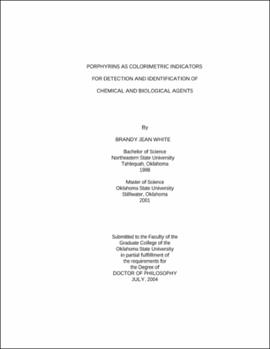| dc.contributor.advisor | Harmon, H. James | |
| dc.contributor.author | White, Brandy Jean | |
| dc.date.accessioned | 2013-11-26T08:26:37Z | |
| dc.date.available | 2013-11-26T08:26:37Z | |
| dc.date.issued | 2004-07 | |
| dc.identifier.uri | https://hdl.handle.net/11244/6919 | |
| dc.description.abstract | Scope and Method of Study: The objective of this study was to design sensor surfaces for rapid, real-time, optical detection of chemical/biological warfare agents and/or environmental pollutants that yield a minimum of false readings. Porphyrins were used as colorimetric indicators for transduction in surfaces using biological recognition elements such as enzymes and as combination recognition element/transducer in other surfaces. Immobilization protocols and assaying procedures were developed for each of the sensor surfaces. | |
| dc.description.abstract | Findings and Conclusions: As a reversible, competitive inhibitor of enzymes, porphyrins can be used for identification and quantification of the presence of a substrate or another competitive inhibitor of the enzyme. This technique has been useful for development of glass surfaces for the detection of cholinesterase inhibitors such as organophosphate compounds and nerve agent simulants at parts per trillion levels using acetylcholinesterase, butyrylcholinesterase, and organophosphorous hydrolase as recognition elements. Evanescent wave absorbance spectroscopy with a small CCD array spectrophotometer allowed for measurements to be completed in less than six seconds. The specificity of the enzyme active site insured a minimum of false responses. In addition, the technique has been demonstrated for detection of glucose using glucose oxidase and for detection of carbon dioxide using carbonic anhydrase. Porphyrins immobilized to cellulose films or to glass surfaces can be used for detection of part per billion levels of cyanide in liquid phase and part per million levels in gas phase. Porphyrins immobilized to cellulose tissues can be used to identify and quantify the presence of dipicolinic acid, a constituent of bacterial endospores in the Bacillus genus, as well as sugars similar to those found in the exosporium of Bacillus anthracis. The tissues may be useful as a wipe test for the indication of the presence of these compounds. | |
| dc.format | application/pdf | |
| dc.language | en_US | |
| dc.rights | Copyright is held by the author who has granted the Oklahoma State University Library the non-exclusive right to share this material in its institutional repository. Contact Digital Library Services at lib-dls@okstate.edu or 405-744-9161 for the permission policy on the use, reproduction or distribution of this material. | |
| dc.title | Porphyrins as colorimetric indicators for detection and identification of chemical and biological agents | |
| dc.contributor.committeeMember | Westhaus, Paul A. | |
| dc.contributor.committeeMember | Wicksted, James P. | |
| dc.contributor.committeeMember | Peakheart, David | |
| dc.contributor.committeeMember | Yu, Chang-An | |
| osu.filename | White_okstate_0664D_1044.pdf | |
| osu.accesstype | Open Access | |
| dc.type.genre | Dissertation | |
| dc.type.material | Text | |
| dc.subject.keywords | navy | |
| dc.subject.keywords | unrestricted line officers | |
| dc.subject.keywords | human resources officers | |
| dc.subject.keywords | fleet operational requirements | |
| dc.subject.keywords | united states navy | |
| thesis.degree.discipline | Photonics | |
| thesis.degree.grantor | Oklahoma State University | |
